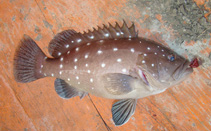
|
Hyporthodus niveatus (Valenciennes, 1828) Snowy grouper |

|
|
photo by
Timm, C.D. |
| Family: | Epinephelidae (Groupers) | |||
| Max. size: | 122 cm TL (male/unsexed); max.weight: 30 kg; max. reported age: 27 years | |||
| Environment: | demersal; marine; depth range 30 - 525 m | |||
| Distribution: | Western Atlantic: Canada (Ref. 5951) to Massachusetts, USA to southern Brazil, including the Gulf of Mexico and the Caribbean. | |||
| Diagnosis: | Dorsal spines (total): 11-11; Dorsal soft rays (total): 13-15; Anal spines: 3-3; Anal soft rays: 9-9. Distinguished by the following characteristics: Dark margin on spiny dorsal fin and dark saddle on caudal peduncle that extends below lateral line (Ref. 26938); juveniles with pale yellow caudal and pectoral fins; black saddle blotch on the caudal peduncle reaching below lateral line; depth of body contained 2.4-2.8 times in SL; head length 2.2-2.4 times in SL; convex interorbital area, width less than or subequal to eye diameter; enlarged serrae at angle of preopercle; distinctly convex upper edge of operculum; posterior nostrils 2-5 times larger than anterior nostrils (Ref. 89707). | |||
| Biology: | Adults occur well offshore on rocky bottoms. Juveniles may be found inshore and are often reported from the northeastern coast of the U.S (Ref. 89707). Adults feed on fishes, gastropods, cephalopods, and brachyuran crustaceans (Ref. 5222). Valuable commercial food fish (Ref. 26938). | |||
| IUCN Red List Status: | Vulnerable (VU); Date assessed: 21 November 2016 (A2bd+4bd) Ref. (130435) | |||
| Threat to humans: | harmless | |||